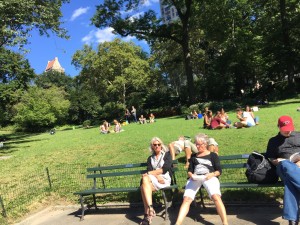Sound and Vid, Wk 1: Sound Walk Response
I went on Janet Cardiff’s Central Park soundwalk this afternoon. It was absolutely beautiful out – sunny, 70 degrees, with a slight breeze. I sat down on a bench underneath the Josi Martin statue and pressed play.
First thing I realized, I couldn’t open the zip file on my phone. Not sure why, but I hadn’t thought that part through beforehand. So obviously a key component of the walk was missing right from the beginning. I will say, however, that Cardiff’s narration allowed me to imagine what I couldn’t see, allowing me to construct an imagined visual layer overtop of the scene in front of me. I found this task especially challenging as she was describing the park in winter, trying to imagine these lush late-summer trees as denuded, cold and lifeless.
I think this play with cognitive dissonance was what I found most compelling about the piece. She describes the park in a state that it isn’t currently in. It’s interesting how suddenly the time of her narrative would change from day to night, asking you to simultaneously be aware of your current place in time and space while superimposing these other details. Or how she points out features or people she passes that aren’t there, though I found myself searching for them all the same. Several times I pulled out my headphones because I couldn’t figure out if the origin of a sound was from the recording or in real life.
What I found even stranger was when things did weirdly match up. The people sunbathing, an asian couple having their wedding photos taken (seriously). You walk in time with the sound of the steps and right where she says there’s a water fountain, there’s a water fountain. It both made sense to see these things (such as architectural elements), but other stuff – specifically people – were a pleasant enhancement, further carrying the narrative.
Perhaps there are certain things that are so consistently New York, and New Yorker activities in Central Park, that they continue to occur despite the year, season, or time of day.
Occasionally, I felt like Cardiff was trying to do a few too many things with the piece. She brings in several different narrative motifs – that of Baudelaire and the slave, as well as Orpheus and Eurydice. At times, I felt these portions to be distracting, pulling attention away from the simple but powerful story of following the path of a series of found photographs rather than enhancing the experience. Another example of this is the experiments, which I enjoyed but also wondered how much they really added to the overall experience. I guess they served some purpose if they stayed with me.
Throughout the walk, I felt like I was insulated from the rest of the park, Cardiff’s voice whispering in my ear. I sort of forgot about everything else, so immersed in this shell of sound. When I’d finished with the narration, I started listening to some music then stopped, pulled out my headphones and tried to pay attention to the sounds that were currently surrounding me. I felt a greater sense of appreciation for the distinct noises and their sources – laughing children, birds in the trees, canoe paddles splashing in the lake. Literally, I felt more in-tune with my surroundings.
